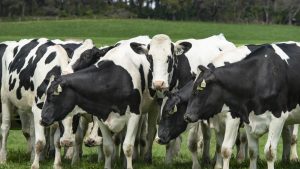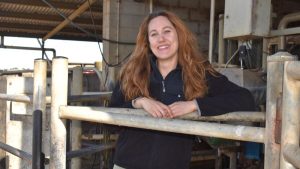
Key points:
-About 180 hectares of the Smart’s 250ha property are underwater following the levee-breach
-The neighbouring buffalo dairy and two other beef cattle properties are expected to be inundated
-It could be a year before the Mypolonga floodplain can again be used for livestock
Local dairy farmer David Smart’s worst fears were realised when he saw the levee fail on his farm Monday afternoon.
“We were down checking the levee bank and headed home and looked down at the river and saw a bit of breach and, ‘Bang’, there it was. The whole farm was going underwater,” he said.
“We were frantically moving dry cows and milking cows to higher ground.”
Mr Smart estimated the levee-breach in the state’s Murraylands had grown from 3 metres to nearly 30 metres in one day, as water rushed through to flood his farm.
About 180 hectares of the Smart’s 250-hectare property have gone underwater, as will the neighbouring buffalo dairy and two beef cattle properties.
It has been estimated that about 2.5 metres of water would cover the 500-hectare floodplain at Mypolonga in two to three days.
There had been concern the levee at Mypolonga would not be high enough to keep the river contained, so Mr Smart built a 3-metre-high levee at a cost of more than $100,000 around his robotic dairy to protect it.
But after the breach he did not think it would be enough to protect his valuable infrastructure.
“The information to hand at the moment could have the river at 3.1 metres, so we’re not sufficient to keep the water out,” Mr Smart said.
The flood peak was still a week or two away from reaching Mypolonga and it could be a year before Mr Smart could use that land again while he waits for river levels to decrease.
Pastures underwater
The cows have coped well so far, milking themselves using the automatic dairy overnight, but keeping them fed without access to pasture would be the next issue to overcome.
“We’ve done some rough calculations [and] it will be 12 tonne of hay per day plus grain for 500 cows,” Mr Smart said.
“Just trying to source it because of the fodder drought is going to be interesting.”
The flood is believed to have already peaked about 225 kilometres upstream in the Riverland town of Renmark, but downstream there were concerns the levees would not hold for much longer.
Overall the River Murray is expected to peak slightly above the 1931 flood level.
Defects in multiple levees
The state government has been monitoring town floodwater defences, including public and private levees.
“As we’ve previously forecast, we’ve continued to see a number of levee breaches over the last few days and a number of significant defects materialise, particularly amongst the agricultural levees and a number of private levees,” State Emergency Service chief officer Chris Beattie said.
There is significant longitudinal cracking in the Riverglen levee at the White Sands caravan park downstream from Murray Bridge.
“We’ve got crews on site again today,” Mr Beattie said.
“We don’t think there’s too many homes that are at risk … there’s also 1,500 hectares of dairy pasture, so we’re engaging with the farmer.”
SA Premier Peter Malinauskas on Tuesday announced $10,000 grants for small businesses, farm enterprises and not-for-profit organisations affected by the floods.
The grants would be available to businesses along the river that had experienced a downturn of 30 per cent or more over a three-month period.
“We’re hopeful that all businesses will survive beyond the floods,” Mr Malinauskas said.
























